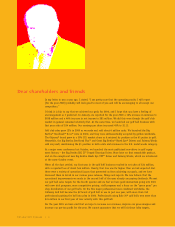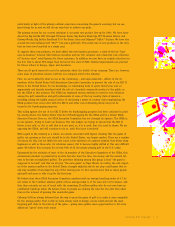Callaway 2000 Annual Report Download - page 20
Download and view the complete annual report
Please find page 20 of the 2000 Callaway annual report below. You can navigate through the pages in the report by either clicking on the pages listed below, or by using the keyword search tool below to find specific information within the annual report.
Callaway Golf Company | 20
related to production of golf balls in 2000. Also contributing to
the decrease were reductions in legal and consulting fees and in
depreciation expense. The overall decrease was partially offset by
an increase in bad debt expense associated with the write-off of
uncollectible accounts.
Research and development expense was $34.6 million in 2000 as
compared with $34.0 million in 1999, and as a percentage of net
sales decreased to 4% from 5%. The nominal increase was primarily
attributable to an increase in employee compensation and benefits.
Interest and other income decreased to $8.8 million in 2000
from $9.2 million in 1999. This decrease is primarily attributable
to the 1999 receipt of insurance proceeds related to the Company’s
deferred compensation plan. This decrease was partially offset by
an increase in royalty income, a decrease in foreign currency
transaction losses, and an increase in interest income associated
with higher average cash balances in 2000 as compared with 1999.
Interest expense decreased to $1.5 million in 2000 from $3.6
million in 1999, as 1999 reflects interest expense associated with
debt balances on the Company’s line of credit, interim finance
agreement for pre-lease financing advances for the acquisition
and installation costs of machinery and equipment, and accounts
receivable securitization facilities. The line of credit and accounts
receivable securitization facilities were not utilized in 2000 and
the interim finance agreement was terminated in 1999.
During 2000, the Company recorded a provision for income
taxes of $47.4 million and recognized a decrease in deferred taxes
of $4.4 million. During 2000, the Company realized $6.8 million
in tax benefits related to the exercise of stock options. The provi-
sion for income tax as a percentage of income before taxes was
37% in 2000 as compared with 35% in 1999. The Company’s effec-
tive tax rate for 2000 reflects a benefit from the consolidation of
Callaway Golf Ball Company with the Company.
The Company adopted Staff Accounting Bulletin No. 101,
“Revenue Recognition in Financial Statements” (“SAB No. 101”)
in the fourth quarter of 2000 with an effective date of January 1,
2000. SAB No. 101 summarizes the SEC’s Division of Corporation
Finance Staff’s views in applying generally accepted accounting
principles to revenue recognition in financial statements. As a
result of the adoption of SAB No. 101, the Company recognized a
cumulative effect adjustment of $1.0 million in the Consolidated
Statement of Operations for the year ended December 31, 2000.
Years Ended December 31, 1999 and 1998
For the year ended December 31, 1999, net sales increased 2%, to
$719.0 million from $703.1 million in the prior year. The increase
is attributable to an increase in sales of metal woods, particularly
titanium metal woods, partially offset by a decrease in sales of
irons and by sales of non-current product, through a managed
close-out process, at substantially reduced prices. The increase in
metal woods sales of $39.1 million (10%) is largely attributable to
the January 1999 introduction of Great Big Bertha® Hawk Eye®
Titanium Metal Woods and increases in sales of Big Bertha®
SteelheadTM Metal Woods, which were introduced in August 1998.
Sales of irons decreased $7.8 million, primarily as a result of a
$27.6 million decrease in sales of Big Bertha® SteelheadTM X-12®
Irons, which were introduced in January 1998, partially offset by
sales from the August 1999 introduction of Great Big Bertha®
Hawk Eye® Tungsten InjectedTM Titanium Irons of $27.7 million.
Sales of Odyssey® and Callaway Golf® putters decreased $7.5 mil-
lion (14%). Sales of other products decreased $6.9 million (30%).
Also included in 1999 net sales were $56.6 million in sales of non-
current product, most of which were sold at close-out prices.
Net sales reflect the effect of a reclassification of shipping rev-
enues from “selling” expenses. This reclassification, which added
$4.6 million to net sales in 1999 and $5.4 million in 1998, was
required by EITF 00-10, and did not result in a change in the
Company’s earnings or earnings per share for either period.
In terms of net sales by region, sales in the United States
decreased 5% to $418.4 million for the year ended December 31,
1999. Net sales in Japan decreased 9% to $55.9 million, as net
purchases by the Company’s distributor declined in anticipation of
the transition of distribution of Callaway Golf® products from it
to the Company’s wholly-owned Japanese subsidiary. Net sales to
Europe decreased 1% to $115.7 million and net sales to the rest
of Asia and the rest of the world increased 114% and 16%, respec-
tively, to $73.1 million and $55.9 million, respectively. Sales to
the rest of Asia increased in 1999 over 1998 due largely to the
economic recovery of the Korean market in 1999 and the intro-
duction of higher-margin products in Korea during 1999. The
Company does not expect that revenue in Korea will continue to
increase at a rate comparable to 1999.
For the year ended December 31, 1999, cost of goods sold
improved to $384.3 million from $410.3 million in the prior year,
and as a percentage of net sales, improved to 53% from 58%.
These amounts include the reclassification of shipping expense
from “selling” expense that resulted from the application of EITF
00-10. This reclassification added $7.9 million to cost of goods
sold during 1999 and $8.7 million in 1998. The decrease in cost of
goods sold is primarily due to lower obsolescence charges in 1999
versus a $30.0 million excess inventory charge recorded in the
MANAGEMENT’SDISCUSSION AND ANALYSIS OF FINANCIAL CONDITION AND RESULTS OF OPERATIONS
























